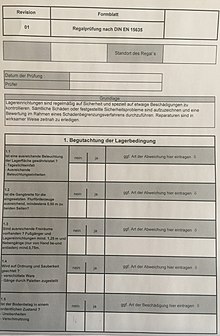Inspection book
A log book is in the Federal Republic of Germany an instrument in the operational industrial safety . It is used to document the regular implementation of testing, monitoring and control of the proper and safe function of technical facilities and equipment in companies. This check is known as a technical examination and colloquially often referred to as "TÜV" - based on the annual general inspection of cars. The results of this test are recorded in the test book.

The term book is not necessarily to be understood literally as a bound work. Both the form, time requirements and content are subject to various different regulations. Therefore, in some cases, continuous loose-leaf collections are also permitted. The test book also regulates all the details of carrying out the inspection and must be presented to authorities on request, e.g. the public prosecutor's office in the event of investigations into serious accidents at work. The entrepreneur is responsible for keeping and keeping the log book, but can delegate this task to an authorized person in individual cases.
Legal basis
The DGUV "Regulation 1 - Principles of Prevention" contains the accident prevention regulations with the fundamentals of the prevention of accidents in everyday business. Sections 2 and 3 result in the employer's obligation to plan, implement and document occupational safety measures. According to Section 3 (3) of the Industrial Safety and Health Ordinance, an employer must record the type, scope and deadlines of required inspections of the work equipment. These regular checks are intended to systematically record and correct safety-related deficiencies in order to minimize occupational accidents and diseases . In the Occupational Safety and Health Act , § 3 and § 6 also oblige the company to take industrial safety measures and to document them. All of this results in the creation and maintenance of a test book for certain technical facilities and equipment.
Depending on the type, condition, area of application and so on, further occupational safety regulations from other ordinances can regulate the creation and maintenance of a test book. To be mentioned here:
- Workplace Ordinance ( ArbStättV )
- Construction site ordinance ( BaustellV )
- Industrial Safety Ordinance ( BetrSichV )
- Ordinance on Hazardous Substances ( GefStoffV )
- Noise and vibration occupational safety regulations ( LärmVibrationsArbSchV )
- Load Handling Ordinance ( LasthandhabV )
- PPE Usage Ordinance ( PSA-BV )
- Ordinance on the Protection of Employees from Risks from Artificial Optical Radiation ( OStrV )
Practical use
The correct, safe function of the equipment is ensured by a qualified person - the expert - in the so-called expert examination. Details of the control such as type, scope or frequency are specified in the inspection book. The formal qualifications of the people who are entrusted with carrying out the test and documenting it in the test book are regulated differently from case to case. The content of the test book and the requirement profiles of the experts can be found in the relevant regulations.
The DGUV regulation 69 for industrial trucks, for example, regulates occupational safety, and thus also the formalities relating to the inspection book, forklifts and other industrial trucks. In this case, the professional association for wood and metal has awarded the qualification for the examination of expertise to ... those who have sufficient knowledge in the field of industrial trucks due to their technical training and experience ... On the other hand, in addition to sufficient professional experience, additional training is required for monitoring cranes Participation in specialist seminars necessary. The necessary prerequisites are also partly controversial. In order to be able to carry out shelf tests according to DIN EN 15635, institutions such as TÜV or DEKRA offer advanced training to acquire this qualification for a fee. Even if the need for such additional training cannot necessarily be derived from the legal basis.

The results of the proficiency test are recorded in the test book. Defects are named and deadlines for their elimination are entered. If there are no major complaints, a test sticker with the next test date is very often attached.
Examples of inspection books
- Test book for winches, lifting and pulling devices (DGUV regulation 54 and 55)
- Test book for lifting platforms (DGUV principle 308-003)
- Test book for industrial trucks (DGUV regulation 67)
- Test book for cranes (accident prevention regulation "cranes" BGV / GUV-V D6)
- Test book for electrical systems and equipment (DGUV regulation 3 and 4 - BGV / GUV-V A3)
swell
- Act on the implementation of occupational safety measures to improve the safety and health protection of employees at work (Occupational Safety and Health Act - ArbSchG)
- German Statutory Accident Insurance (DGUV) - Regulation 1
Individual evidence
- ↑ Testing of industrial trucks. In: uvv-sapler.de. Retrieved April 3, 2019 .
- ^ Testing of cranes. In: Berufsgenossenschaft Holz und Metall. December 14, 2015, accessed April 3, 2019 .
- ↑ Information on shelf testing. In: Employer's Liability Insurance Association for Raw Materials and Chemical Industry (BG RCI). September 1, 2014, accessed April 3, 2019 .